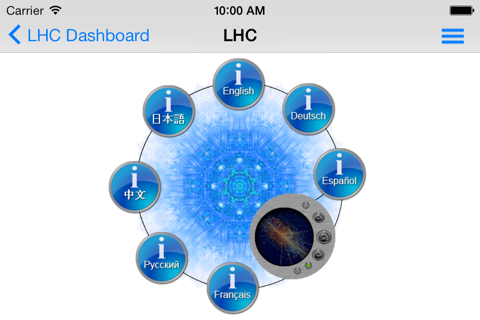
Large Hadron Collider
Large Hadron Collider sehr gutes Programm aus Dzianis Azarenka
Release-Datum 13 years ago 10.12 version.The LHC lies in a tunnel 27 kilometres (17 mi) in circumference, as much as 175 metres (574 ft) beneath the Franco-Swiss border near Geneva, Switzerland. This synchrotron is designed to collide opposing particle beams of either protons at an energy of 7 teraelectronvolts (7 TeV or 1.12 microjoules) per particle, or lead nuclei at an energy of 574 TeV (92.0 µJ) per nucleus. The term hadron refers to particles composed of quarks.
The Large Hadron Collider was built by the European Organization for Nuclear Research (CERN) with the intention of testing various predictions of high-energy physics, including testing for the existence of the hypothesized Higgs boson and of the large family of new particles predicted by supersymmetry. It was built in collaboration with over 10,000 scientists and engineers from over 100 countries, as well as hundreds of universities and laboratories.
On 10 September 2008, the proton beams were successfully circulated in the main ring of the LHC for the first time, but 9 days later operations were halted due to a serious fault. On 20 November 2009 they were successfully circulated again, with the first recorded proton–proton collisions occurring 3 days later at the injection energy of 450 GeV per beam. After the 2009 winter shutdown, the LHC was restarted and the beam was ramped up to half power, 3.5 TeV per beam (i.e. half its designed energy). On 30 March 2010, the first planned collisions took place between two 3.5 TeV beams, a new world record for the highest-energy man-made particle collisions. The LHC will continue to operate at half power for some years; it will not be running at full power (7 TeV per beam) until 2014.
Physicists hope that the LHC will help answer some of the fundamental open questions in physics, concerning the basic laws governing the interactions and forces among the elementary objects, the deep structure of space and time, and in particular the intersection of quantum mechanics and general relativity, where current theories and knowledge are unclear or break down altogether.
Keywords for App: Large Hadron Collider, hadron collider, collider, collide, nuclear, research, nuclear research, CERN, LHC, ATLAS, CMS, ALICE, LHCb, LHCf, TOTEM, BNL, MoEDAL, physics, physic, protons, quarks, Higgs boson, boson, high-energy, synchrotron, tevatron, laws of nature, nature, universe, particle beams, highest-energy, particle accelerator, teraelectronvolt, collisions, toroidal, supersymmetry, muon, solenoid, experiment, Ion, helium, diffraction, Geneva, Switzerland, Large Ion Collider, Total Cross Section, Elastic Scattering, Diffraction Dissociation, LHC-forward, Monopole and Exotics Detector, Intersecting Storage Rings, Relativistic Heavy Ion Collider
Disclaimer:
This application was developed by Information Security Center Ltd, a privately held company which is NOT connected in any way with CERN, the European Organization for Nuclear Research, or experiments around the LHC. All the information about the LHC used in this application is freely available on the Internet.
Andere Anwendungen von Dzianis Azarenka
Smoordie IQ FreeSmoordie IQ Pro
Radio Pro HQ
Radio HQ (lite version)
Indigo Kids - IQ Test
Indigo IQ Pro
Radio Germany HQ
Radio Italy HQ
Radio Japan HQ
Radio Mexico HQ





